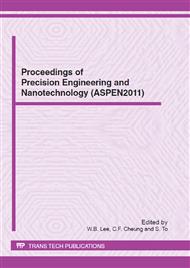p.452
p.457
p.463
p.469
p.475
p.481
p.487
p.492
p.498
Gloss Estimating Method of Finished Surface Machined by Ball Nose End-Milling under Constant Contact Angle with a Five-Axis Controlled Machining Center
Abstract:
In recent years, studies have been conducted about creating metal moulds using a five-axis controlled machining centre with ball end milling. Most of these reports concern the programming of CAM based on geometry. However, there have been few reports related to polish-less finished surface. Furthermore, a specular surface like a mirror and finishing under a constant angle between ball end milling and the work piece have not been investigated. Therefore, this paper deals with the gloss of the machined surface when feed rate and pick-feed rate are changed to maintain constant surface roughness considering tool run-out under the condition that the angle between the tool and work piece in contact are inclined at 15. However, by changing the combination of feed rate and pick-feed rate, various specular changes and direction of disposition of reflected light were obtained. Therefore, we suggest a new method of evaluating the gloss of these finished surfaces. Comparing results by the proposed method with ones by a glossmeter, it is clear that an appropriate ratio of feed rate and pick-feed rate is important for obtaining finished surface. Moreover, it is demonstrated that the proposed method is effective for estimating the gloss of the machined surface.
Info:
Periodical:
Pages:
475-480
Citation:
Online since:
June 2012
Authors:
Price:
Сopyright:
© 2012 Trans Tech Publications Ltd. All Rights Reserved
Share:
Citation:


